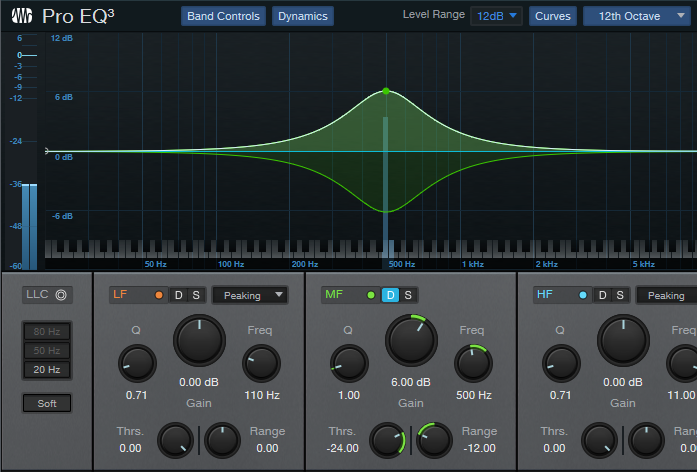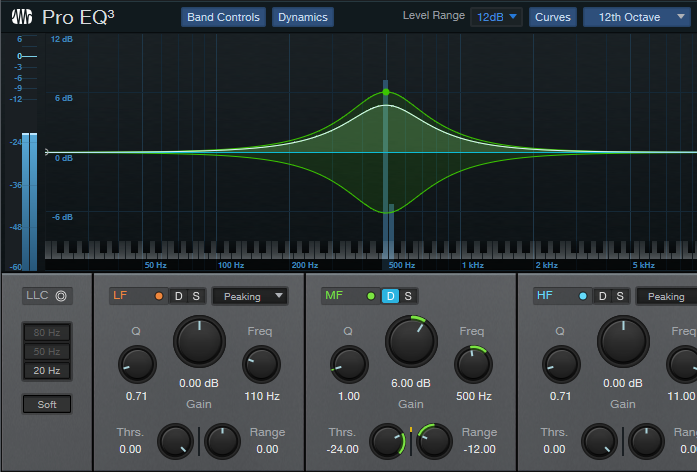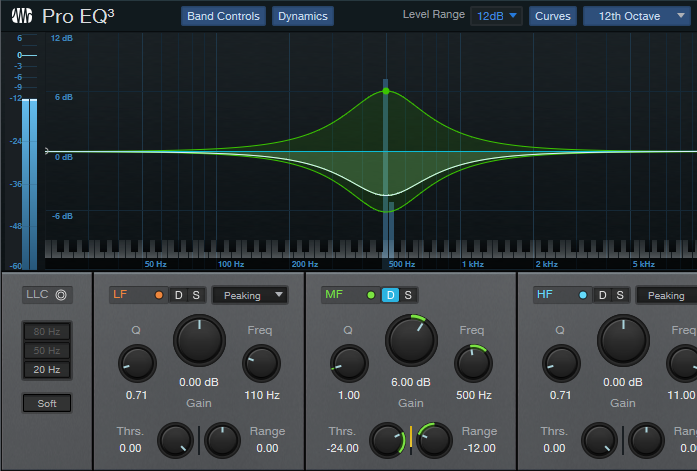Plug-In Matrimony: Pro EQ3 Weds Dynamics

Studio One’s Pro EQ3 represents a major evolution to the Pro EQ. It now incorporates dynamic EQ, effectively but unobtrusively—if you want, you can treat EQ3 just like you did EQ2. Another addition is solo buttons for individual bands. This is useful with standard EQ, but is particularly useful with dynamic EQ.
Dynamic EQ Basics
Dynamic EQ boosts or cuts over a specific frequency range, like standard EQ. However, the boosting or cutting doesn’t occur until the audio in that frequency range crosses over a threshold. The higher the audio level is compared to the threshold, the greater the amount of boost or cut.
De-essing is a basic example of dynamic EQ. High-frequency “ess” sounds aren’t processed unless they exceed a threshold. When they do, the dynamic EQ cuts the response in that range. The stronger the ess sound, the greater the attenuation. Another example is attenuating excessively loud cymbals if they exceed a threshold.
Superficially, dynamic EQ may seem like multiband dynamics. Both combine dynamics processing and equalization. However, multiband dynamics processors use crossover filters to split the incoming audio into multiple, fairly broad bands. The EQ3 processes frequencies with the precision of its usual peaking and shelf EQ stages, using as many or as few stages as needed.
A more technical difference is that crossover filtering is fairly drastic. This introduces phase shifts, unless a multiband dynamics processor uses linear-phase filters. Dynamic EQ is less likely to require super-drastic settings, which minimizes potential phase shifts.
Let’s Get Dynamic!
To use Studio One’s Pro EQ3 for dynamic EQ processing:
- Click the Dynamics button toward the EQ3’s top. This reveals Threshold and Range controls for the parametric/shelving stages.
- Check that the Curves button is enabled, so you can see the curves that the dynamic EQ stages generate.
- Click a stage’s D button to enable its dynamic equalization response.
The display unambiguously shows how dynamic EQ processes the sound. The white curve is the usual curve that shows a stage’s amount of boost or cut. Varying the Range parameter adds a second curve. It uses the same color as its associated EQ stage. This curve represents the maximum amount of gain change that can occur once a signal exceeds the threshold.
Let’s look at a practical example. A 500 Hz sine wave from the Tone Generator feeds the Pro EQ3 MF peaking stage, which is set to 500 Hz.

In fig. 1, according to the meter on the right, the input signal is at -36 dB. This is below the dynamic EQ stage’s threshold (which is -24 dB), so the EQ is not affected. The white curve shows that the EQ is applying 6 dB of gain at 500 Hz, just like a standard EQ stage.
The green curve graphically shows the available range of dynamic processing, as specified by the Range control. Range is set to -12 dB, and the curves confirm this—the range from the current +6 dB of gain to the maximum ‑6 dB cut is -12 dB.

In fig. 2, the input signal is now above the -24 dB Threshold. Because the Range value is negative, audio above the threshold reduces the EQ’s gain. The white line has now moved downward to show that the EQ’s gain is no longer 6 dB, but has been pushed down because the input signal is above the threshold.

In fig. 3, the input is just under -12 dB. This is almost at the maximum available negative range. The white curve shows that the EQ stage has gone from a boost to a substantial cut. Also, note the yellow bar meter to the left of the Range knob. This displays the reduction amount.
That’s really all there is to understanding dynamic EQ—in future tips, we’ll get into practical applications.
Heads-up: Version 1.3 of The Huge Book of Studio One Tips and Tricks is now available! This 637-page book with 230 innovative tips is a free update to owners of previous versions ($19.95 to new buyers). Download the update from your PreSonus or Sweetwater account the same way you downloaded your previous version. For more information, check out the series of Studio One eBooks. Please note: version 1.3 does not cover the new features in version 6, although there will be a free update in the future. If you have questions about the tips, suggestions for future updates, or want news about the next version, please visit the dedicated support forum.
Related: Here’s Gregor taking a closer look at ProEQ3 in action, as well as the other new plug-ins in Studio One 6!